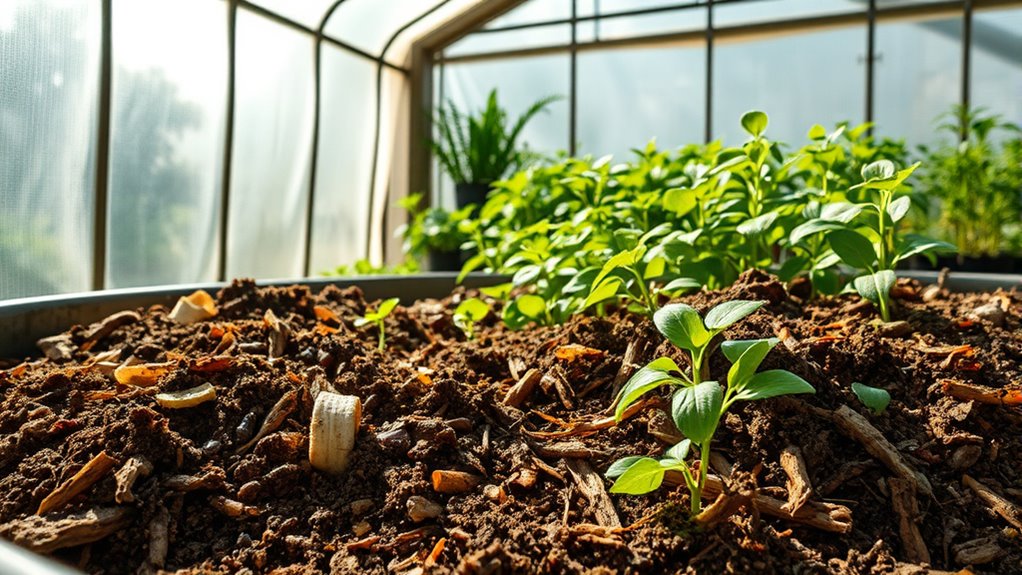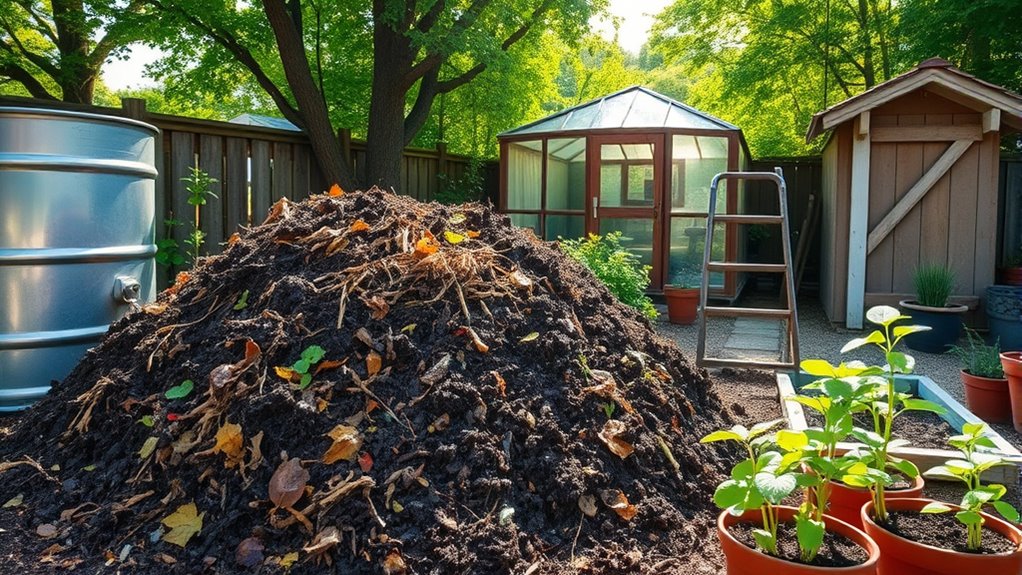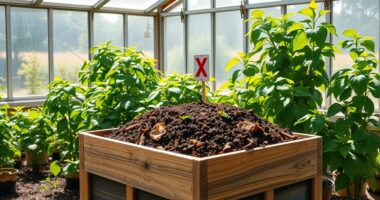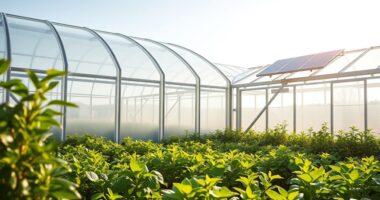To improve your greenhouse soil, start composting with a good balance of green and brown materials to create rich, organic matter that boosts soil fertility. Incorporate worm castings for added nutrients and beneficial microbes that promote healthy plant growth. Use compost tea regularly to enhance microbial activity and nutrient availability. Consistent composting practices build long-term soil health, leading to vibrant, vigorous plants. Keep exploring this approach to open even more tips for thriving greenhouse soil.
Key Takeaways
- Incorporate well-balanced compost with green and brown materials to improve soil fertility and structure in greenhouses.
- Add worm castings to compost for enhanced nutrient content and beneficial microbial activity.
- Use compost tea regularly to boost microbial diversity and nutrient availability in greenhouse soil.
- Ensure proper aeration and moisture during composting to produce mature, high-quality compost for amendments.
- Apply compost and worm castings together for immediate nutrient boost and long-term soil health in greenhouse environments.

Composting is an effective way to improve your greenhouse soil by adding rich, organic matter that promotes healthy plant growth. When you compost properly, you create a nutrient-dense environment that encourages strong root development and vigorous plants. One of the best ways to boost your compost’s effectiveness is by incorporating worm castings. These nutrient-rich excrements from worms are a powerhouse of essential minerals and beneficial microbes that enhance soil fertility. Worm castings help improve soil structure, retain moisture, and provide a slow-release source of nutrients, making them ideal for your greenhouse. You can add worm castings directly to your compost pile or mix them into your soil for an immediate boost.
In addition to worm castings, making compost tea is a simple yet powerful method to deliver nutrients and beneficial microbes directly to your plants. Compost tea is brewed by steeping finished compost in water, often with aeration, to extract the microorganisms and nutrients. When you spray compost tea onto your greenhouse plants, you’re giving them a natural, organic fertilizer that increases their resilience against pests and diseases. It’s a quick way to enhance microbial activity in your soil, which is vital for nutrient cycling and plant health. Regularly applying compost tea helps maintain a vibrant, living soil that supports vigorous growth. Soil health is a foundational element in successful greenhouse gardening and can be significantly improved through these composting practices.
To get the most out of your compost, aim to balance green and brown materials, ensuring a good mix of nitrogen and carbon sources. As your compost matures, the presence of worm castings will become more prominent, enriching the mixture with beneficial organisms. When you harvest your compost, consider blending in worm castings before applying it to your greenhouse beds. This combination provides immediate nutrient availability while building long-term soil health. Applying compost tea periodically, especially during active growth phases, will keep your plants nourished and thriving.
Frequently Asked Questions
How Long Does Composting Typically Take for Greenhouse Use?
Composting for greenhouse use usually takes about three to six months, depending on conditions. You’ll want to monitor compost maturity, which means it’s dark, crumbly, and has an earthy smell. During this time, nutrient content increases, making it ideal for your soil. Turning the pile regularly speeds up decomposition, ensuring your compost is ready faster. When it’s mature, you’ll see ideal nutrient levels for healthy plant growth.
Can Composting Be Done Indoors for Greenhouse Soil?
Did you know that indoor composting can reduce waste by up to 30%? Yes, you can do indoor composting for your greenhouse setup, making it an eco-friendly option. It’s practical, especially if space is limited, and helps produce rich soil amendments right at home. Just guarantee you control moisture and airflow, and use suitable compost bins designed for indoor use. This way, your greenhouse soil stays healthy and sustainable.
What Are the Best Temperature Ranges for Composting?
You should aim for a temperature range of 135-160°F (57-71°C) for effective composting. Maintaining this temperature control boosts microbial activity, which speeds up decomposition and kills pathogens. When temperatures drop below 130°F (54°C), microbial activity slows, prolonging the process. Consistently monitoring and adjusting your compost’s temperature guarantees ideal conditions, leading to rich, healthy soil amendments perfect for your greenhouse plants.
How Do I Prevent Pests in Compost Piles?
To prevent pests in your compost piles, practice pest-resistant composting by avoiding meat, dairy, and greasy foods. Turn your compost regularly to aerate and keep pests away. Use natural pest deterrents like crushed garlic or chili powder around the pile’s edges. Cover your compost with a tight-fitting lid or landscape fabric to block pests from accessing it. These steps help maintain a healthy, pest-free compost environment.
Is There a Specific Compost Ratio for Greenhouse Soil?
Think of your compost ratio as the recipe for a perfect dish. For greenhouse soil, aim for a balanced mix like 3 parts carbon-rich materials (browns) to 1 part nitrogen-rich materials (greens). This ratio helps guarantee healthy decomposition and nutrient-rich soil. Adjust as needed based on compost moisture and texture, but maintaining this balance will give you the best results for your greenhouse soil.
Conclusion
By composting, you’re planting a secret garden beneath your greenhouse’s surface, turning scraps into rich, earthy treasure. Like a gentle rain nourishing thirsty soil, your efforts breathe life into tired ground, transforming it into a lush, vibrant bed of growth. With each turn and blend, you’re crafting a symphony of nutrients waiting to burst into bloom. Embrace composting, and watch your greenhouse become a thriving oasis, bursting with the promise of abundant, healthy plants.









